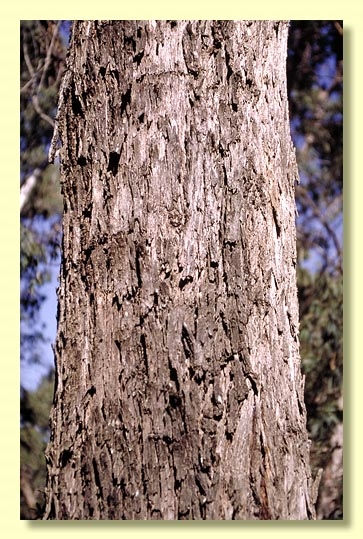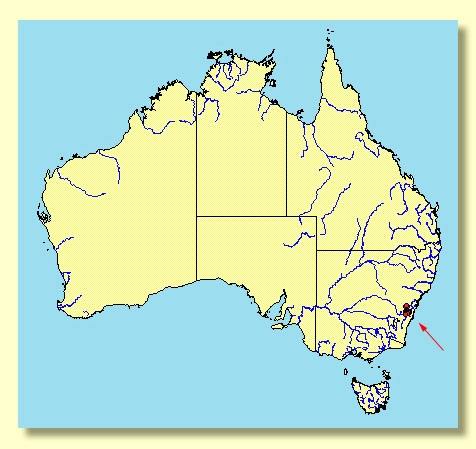Euclid - Online edition
Eucalyptus macarthurii
Eucalyptus | Symphyomyrtus | Maidenaria | Triangulares | Foveolatae
Eucalyptus macarthurii H.Deane & Maiden, Proc. Linn. Soc. New South Wales 24: 448 (1899).
T: New South Wales. Argyle, W. Macarthur 142, anno 1854 (lecto K [K000279769]; fide Brooker et al, 'Forest Trees of Australia' Edition 4, p. 466 (1984); see also Bean, A.R., Telopea 12(3): 315 (2009).
Eucalyptus diversifolia Woolls, Contr. Fl. Australia 235 (1867), nom. illeg. non Bonpl. (1813). T: not designated.
Bark rough, fissured longitudinally, fibrous, often hard, grey, continuing to smaller branches or the branches < 8 cm diameter smooth, ribbons sometimes conspicuous in the crown.
Juvenile growth (coppice or field seedlings to 50 cm): stem rounded in cross-section, often warty; juvenile leaves opposite, sessile, broadly lanceolate to ovate to cordate or deltoid, 3.5–7 cm long, 2.5–4.5 cm wide, stem-clasping, discolorous, dull, grey-green or green.
Adult leaves alternate, petiole 1–2 cm long; blade narrowly lanceolate to falcate, 9–18 cm long, 1–2.5 cm wide, base tapering to petiole, concolorous, glossy, green, side-veins greater than 45° to midrib, moderately to densely reticulate, intramarginal vein parallel to and just within margin, oil glands mostly island.
Inflorescence axillary unbranched, peduncles 0.4–1 cm long, buds 7, sessile to shortly pedicellate, pedicels 0–0.2 cm long. Mature buds ovoid (0.25–0.5 cm long, 0.2–0.35 cm wide), green to yellow, scar present, operculum conical to beaked (0.2–0.3 cm long), stamens inflexed, anthers cuboid to oblong, versatile, dorsifixed, dehiscing by longitudinal slits (non-confluent), style long, stigma blunt, locules 3 or 4, the placentae each with 4 vertical ovule rows. Flowers white.
Fruit sessile or pedicellate, pedicels 0–0.2 cm long, obconical to campanulate, 0.2–0.5 cm long, 0.4–0.6 cm wide, disc raised-convex, valves 3 or 4, exserted or near rim level.
Seeds dark brown or black, 1.5–2.2 mm long, ovoid or flattened-ovoid, often pointed at one end, usually lacunose, dorsal surface smooth or shallowly pitted, hilum ventral.
Cultivated seedlings (measured at ca node 10): cotyledons bilobed to oblong; stems rounded in cross-section, warty; leaves opposite and sessile for many nodes, cordate, 4–7 cm long, 2.5–4.5 cm wide, amplexicaul, margin entire, apex pointed, slightly discolorous, dull, mid-green.
Flowering has been recorded in January and May.
A medium-sized to tall tree of the Central and Southern Tablelands of New South Wales between the Blue Mountains and Goulburn. E. macarthurii is related to the small-fruited swamp gums. The rough bark is often ragged and extends to the larger branches but the smaller branches are smooth; the crown is ribbony with shedding bark. Leaves are small and narrow, buds in sevens, somewhat like E. aggregata, and it usually grows near water. E. macarthurii is distinguished from similar species and others in the vicinity by the conspicuous, large, opposite, sessile, ovate, grey-green juvenile leaves
Eucalyptus macarthurii belongs in Eucalyptus subgenus Symphyomyrtus section Maidenaria because the cotyledons are bilobed, inflorescences axillary, anthers versatile and seeds flattened-ovoid. Within this large section, E. macarthurii is one of 10 species forming series Foveolatae further characterised by swamp habitat and fruit more or less obconical.
Eucalyptus macarthurii is naturalized around Emerald in the Dandenong Ranges of Victoria.













